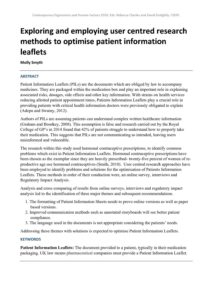| Document | Author Molly Smyth |
| Abstract Patient Information Leaflets (PILs) are the documents which are obliged by law to accompany medicines. They are packaged within the medication box and play an important role in explaining associated risks, dosages, side effects and other key information. With strains on health services reducing allotted patient appointment times, Patients Information Leaflets play a crucial role in providing patients with critical health information doctors were previously obligated to explain (Adepu and Swamy, 2012). Authors of PILs are assuming patients can understand complex written healthcare information (Graham and Brookey, 2008). This assumption is false and research carried out by the Royal College of GP’s in 2014 found that 42% of patients struggle to understand how to properly take their medication. This suggests that PILs are not communicating as intended, leaving users misinformed and vulnerable. The research within this study used hormonal contraceptive prescriptions, to identify common problems which exist in Patient Information Leaflets. Hormonal contraceptive prescriptions have been chosen as the exemplar since they are heavily prescribed- twenty-five percent of women of re-productive age use hormonal contraceptives (Smith, 2010). User centred research approaches have been employed to identify problems and solutions for the optimisation of Patients Information Leaflets. These methods in order of their conduction were, an online survey, interviews and Regulatory Impact Analysis. Analysis and cross comparing of results from online surveys, interviews and regulatory impact analysis led to the identification of three major themes and subsequent recommendations. 1. The formatting of Patient Information Sheets needs to prove online versions as well as paper based versions. 2. Improved communication methods such as annotated storyboards will see better patient compliance. 3. The language used in the documents is not appropriate considering the patients’ needs. Addressing these themes with solutions is expected to optimise Patient Information Leaflets. |

